When thinking about lithium batteries the average person jumps to things like smartphones and cordless tools, but lithium power goes far beyond what fits in our pockets.
Now widely used on boats, these powerful, rechargeable batteries run everything from action cameras and electric scooters to critical on-board systems, power tools and even outboard motors. With their promise of high efficiency and compact storage, lithium batteries make boating more convenient. Yet, despite their perks, improper use of lithium batteries on boats has led to serious accidents.
To help keep yourself and your boat safe, let’s dive into what lithium batteries are, the risks associated with improper use, and how to install and use them safely out on the water.
Cautionary tales; when lithium goes wrong
A nightmare in the back of the mind of every cruiser is losing the boat in a life threatening situation. In November 2022, French sailor Fabrice Amedeo narrowly escaped his burning racing yacht, “Nexans – Art & Fenêtres” while en route to Portugal. The culprit? A damaged ballast tank that leaked water onto lithium-ion batteries, sparking a short circuit that caused a massive fire. The boat sank soon after ignition and hours later, Amedeo was finally rescued by a cargo ship’s crew.
Sadly this isn’t a one-off story. In 2018, the yacht “Kanga” burned down near the Croatian coast. Crew members noticed a small fire in the dinghy garage, but the flames quickly spread across the vessel, forcing everyone to abandon ship. Later, investigators linked the fire to damaged lithium-ion batteries on a foil board.
In both cases, crew members hadn’t realized how much risk damaged lithium batteries pose. These stories underscore the importance of proper handling and storage.
Why lithium batteries are so powerful (and why they can be dangerous)
Lithium batteries can store a surprising amount of power in a compact space, making them ideal for small mobile devices and off-grid electrical systems. They charge quickly, last for many cycles and are lighter than comparable AGM batteries. The trade-off? High energy density comes with certain risks. When damaged or improperly stored, these batteries can release energy unpredictably, even explosively.
Looking at the structure, lithium batteries are made of several cells, each with a positive and a negative electrode separated by an electrolyte. This electrolyte carries lithium ions back and forth as the battery charges and discharges. A separator keeps the electrodes from touching directly, preventing shorts and keeping the battery working as it should. But if this barrier doesn’t do its job things can go south fast, leading to what’s called “thermal runaway.” One cell overheats, then the rest follow, creating a chain reaction that can end in devastating consequences.
Fire hazard associated with lithium batteries on boats
Most boaters will have both lithium-ion battery (Li-on) and lithium iron phosphate batteries (LiFePO4) aboard. The lithium-ion battery (Li-on) batteries are used to power devices like drones, water toys, electric scooters and tools, while lithium iron phosphate batteries (LiFePO4) are used in house battery banks to power the vessel’s systems.
Before delving into this topic any further it’s important to get one thing straight; when professionally installed and/or used according to manufacturer instructions, modern lithium batteries are generally safe. But if they’re damaged, have manufacturing defects or are used improperly, then they can become a fire hazard.
If a thermal runaway is triggered with a lithium-ion battery (Li-on) the ensuing chain reaction causes temperatures to skyrocket, leading to flames, smoke, and possibly an explosion. Lithium iron phosphate batteries (LiFePO4) don’t react as violently as lithium-ion batteries, but can still smolder and ignite under extreme stress.
Once a battery fire starts, it’s tough to stop. These fires produce their own oxygen, making them resistant to conventional extinguishers. In smaller battery fires, cooling with water might work, but only if you can reach the battery directly. Larger lithium fires often need massive quantities of water to bring temperatures down and prevent the reaction from reigniting, or the use of specialized equipment such as a fire extinguisher specifically for lithium battery fires.
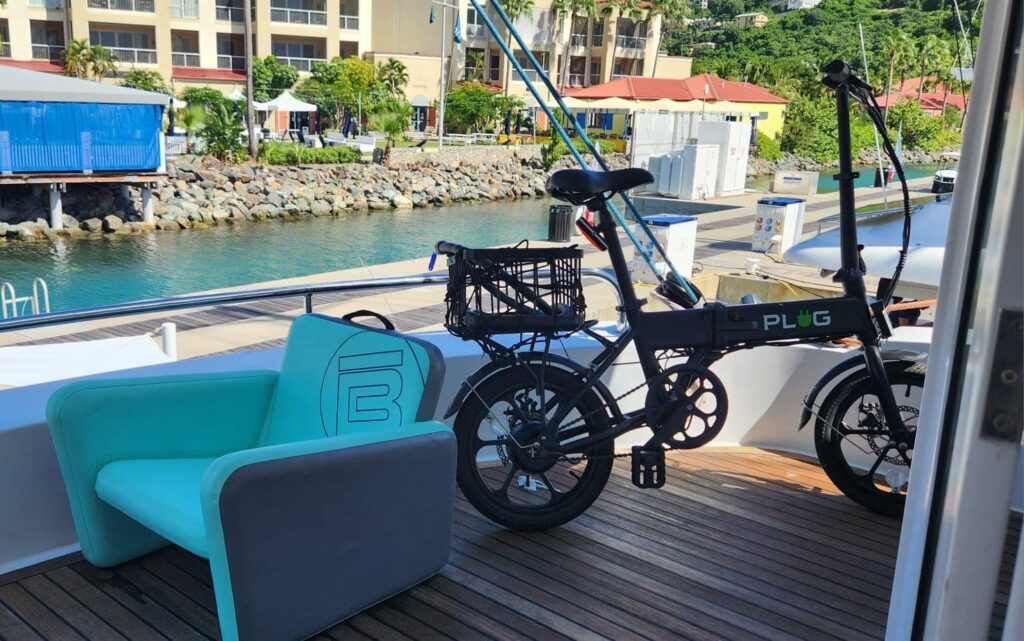
Keeping lithium batteries cool, dry, and protected
One of the best ways to protect your lithium batteries, whether they’re lithium-ion or LiFePO4, is to mitigate known risk factors.
Temperature
Temperature extremes are no friend to lithium batteries. Both heat and cold can damage them, increasing the chance of failure. Ideally, batteries should be stored in moderate conditions, away from direct sunlight and heat. This is especially important during charging, which is a high risk time. If they’re left in a hot place, like a boat deck in midsummer, the internal components can be stressed, increasing the risk of fire.
Water
As mentioned, water can be of little use during a lithium fire, and if lithium batteries get wet it can also pose a risk. This is because water can cause the battery to short circuit. As it subsequently heats up, the unit can ignite, so it’s best to ensure your lithium batteries are stored or installed in dry areas.
Deep discharge
Fully draining a lithium battery, or deep discharging them, creates another potentially hazardous situation. When a battery is fully depleted, the cells can be damaged and may spontaneously ignite during the next charge. Many modern devices do have built-in fail-safes that prevent deep discharge from occurring, but it’s best to check the battery charge level periodically and recharge before it gets critically low.
International standards for lithium batteries on boats
Navigating the waters of lithium battery safety can feel daunting, especially when it comes to following best practices. Fortunately, there are international standards designed to improve lithium battery safety on boats. The International Electrotechnical Commission (IEC), American Boat and Yacht Council (ABYC) and Australian and New Zealand Standards (ASNZ) are among the recognized groups to provide guidelines on lithium battery design, installation, and management for marine applications.
To give you some practical examples of what the standards cover, IEC standard 62619 covers safety protocols that test batteries under various conditions to ensure they can handle the marine environment. The ABYC E-13 standard emphasizes safe installation, grounding, and proper fuse selection, helping to prevent electrical malfunctions. Following these guidelines is highly recommended for boat owners looking to upgrade their vessels with lithium technology, and adherence to them is often a requirement for the installation to be covered by your yacht insurer.
Tips for safely handling lithium power on boats
Handling lithium batteries on a boat takes some extra care to ensure the installation is safe, but for many cruisers it’s worth it when weighed against the great benefits of a lithium powered electrical system or consumer devices.
Here’s some tips for safely handling lithium on your boat.
- Have the installation and commissioning of LiFePO4 house banks and battery management systems done by a professional, choosing systems and components designed to handle the marine environment
- Store or install lithium batteries in watertight spaces, protected from sun, heat and water, and install fire detectors up high for smoke, and down low for vapors
- Consider getting a fire extinguisher designed for lithium fires or lithium storage containers for portable lithium batteries
- Replace damaged batteries and don’t reuse or resell them
- Inform your yacht insurance company of the installation of a lithium battery system
- Never leave loose lithium batteries charging unsupervised for extended periods, unplug when finished charging and avoid using non-certified or knock-off chargers
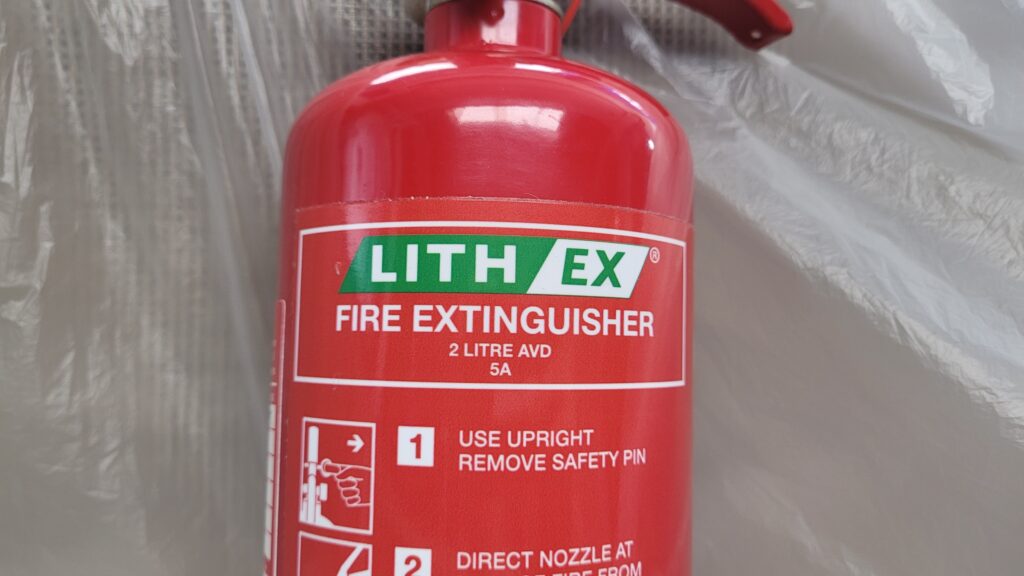
What to do if a lithium battery catches fire on board
If a lithium battery fire does break out, prioritize safety. Lithium fires produce toxic gasses that pose serious health risks if inhaled, so it’s best to keep your distance and alert others. Smaller devices, like smartphones, may be able to be managed by pouring lots of water on the battery and placing it in a large water-filled container to cool the cells.
With larger batteries, like those powering water toys or outboard motors, don’t try to fight the flames directly. Instead it’s best to evacuate the immediate area and call emergency services, ensuring you tell them it’s a lithium fire. Tossing the battery overboard should be treated as a last-ditch option to protect your boat from further damage, as it is harmful to the environment, and only in spaces where it wouldn’t represent a danger to neighboring yachts.
Thinking about getting lithium?
For boaters considering a switch to lithium for powering their electrical system, modern lithium iron phosphate (LiFePO4) batteries offer a safer alternative to standard lithium-ion options, with a reduced risk of thermal runaway. However, before making the leap, it’s crucial to have a technician assess your boat’s electrical system, including wiring, fuses, and charging components. A thorough check now can prevent costly damage and safeguard your investment.
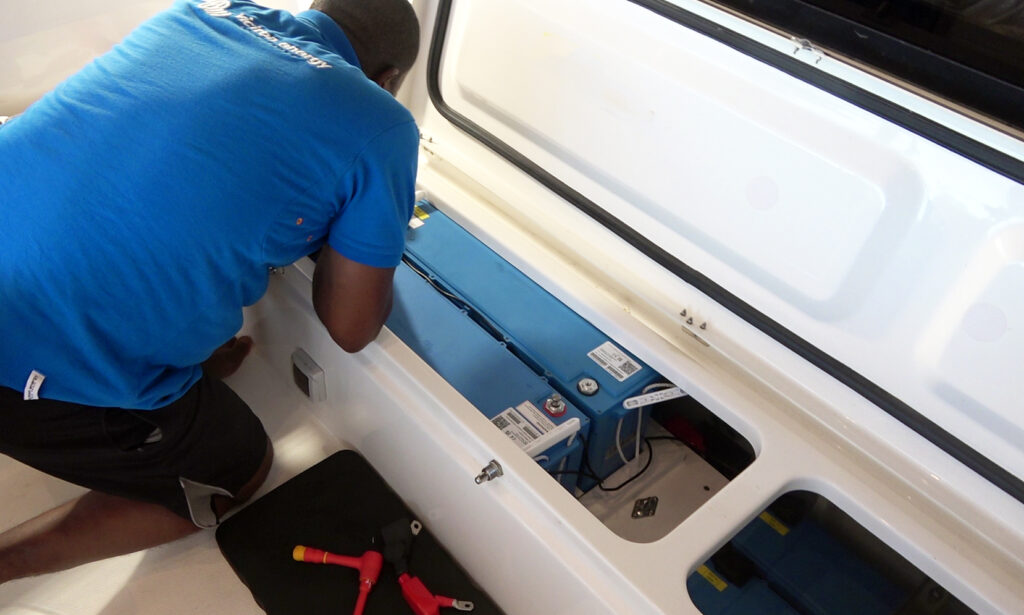
What do you think?
Lithium batteries bring undeniable advantages to modern boating, but their power comes with unique safety concerns. From understanding how to handle extreme weather and storage conditions to learning what to do in an emergency, boaters can protect themselves and their vessels by staying informed and following best practices. If you’re already a lithium battery user, share your experience! What tips or insights have you discovered for keeping these powerful devices safe and functional at sea?

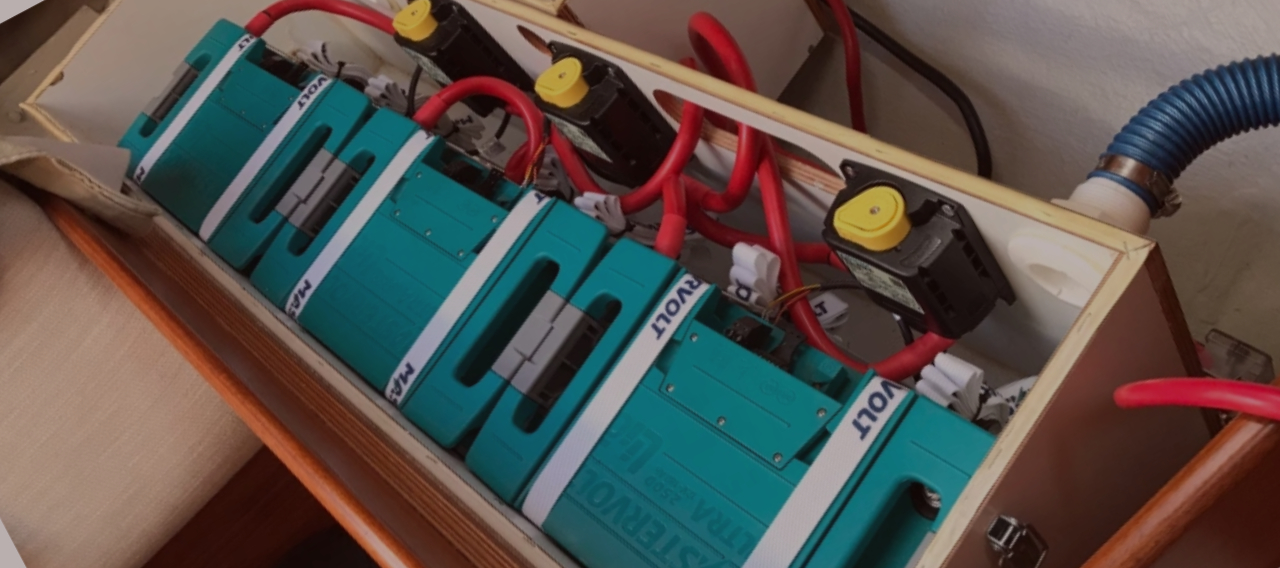


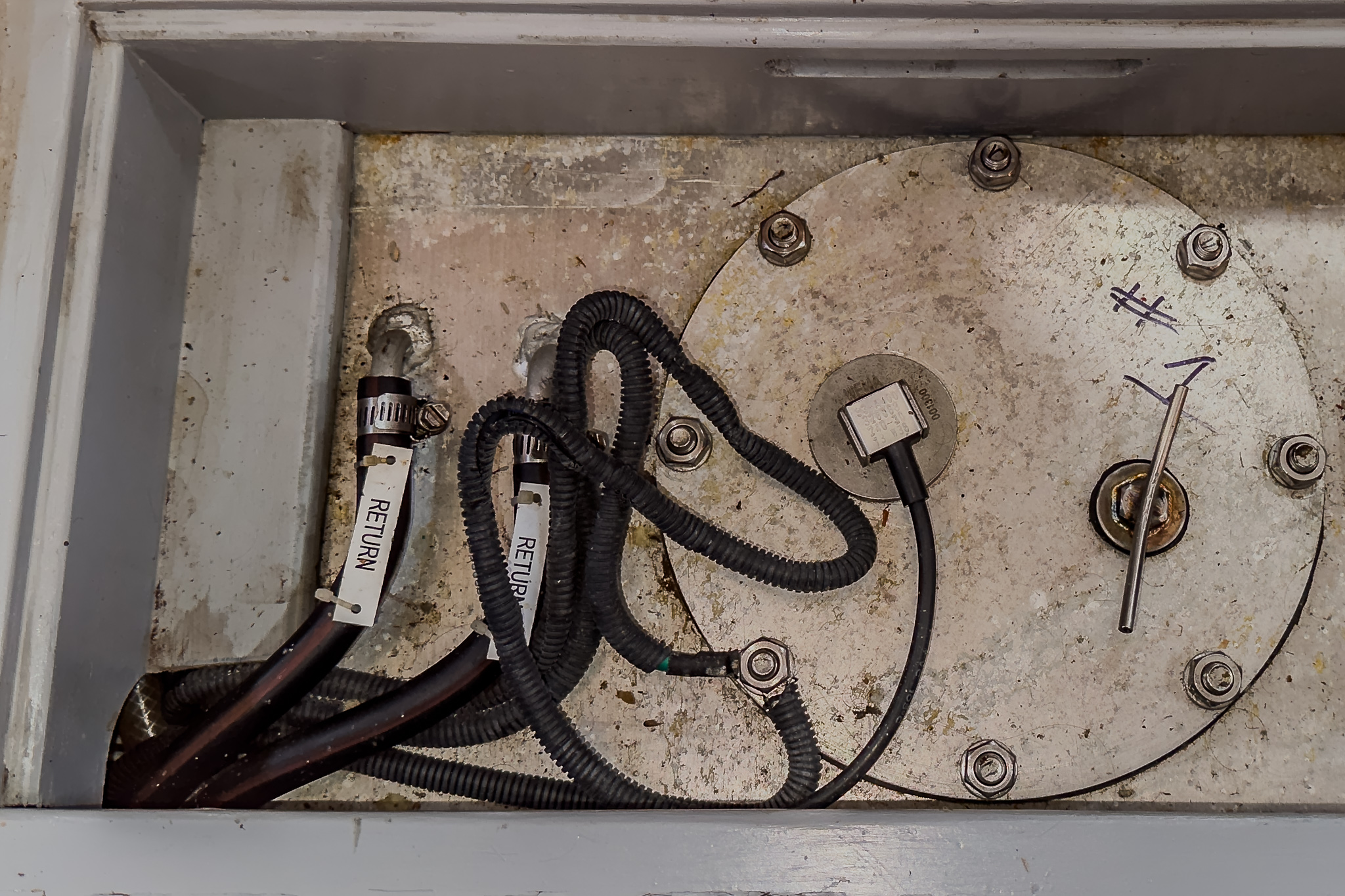

You are absolutely right safety as to be taken as a serious matter when switching to LFP.
I have installed (DIY project, but I have electricity degree) my LFP, I selected prismatic cells that are encapsulated in a rigid plastic container designed by CALB and used in aéronautique. Since the whole market has shifted to aluminium casing wich I think is less resistant over the time, especially in case the bottom gets in contact with salt water.
I have built 11KWh for house battery, I start my engine with another 2KWh and another one for my bow propeller and windlass.
After 4 years of intensive usage, I can say I would never come back to Lead acid, AGM or Gel. Never. 😎
This article is misinformed – there is a vast difference between Lithium Ion batteries (EVs, power tools, e-scooters, phones, tablets and other consumer goods with lithium batteries) and LiFePO4 (LFP) batteries. LFP batteries cannot explode, experience thermal runaway, spontaneously bursting into flames. If conflating the two types of lithium batteries is how an insurance company considers lithium, no wonder premiums and coverage are affected negatively. Absolutely, install LFP batteries properly and design and build a proper system that ensures they perform as expected and are protected from harmful conditions. As for the lithium batteries in phones, e-toys, power tools, etc., don’t keep them on chargers unattended and keep their sizes small. For items with larger batteries such as scooters and bikes and foil boards, keep them above decks.
Thanks for pointing this out. I get so frustrated with people saying all lithium is the same
Thanks, I came here to say the same… fear mongering about “Lithium” without properly distinguishing the chemistry differences. LiFePO4, to my knowledge, has a perfect safety record. Zero fires.
My thoughts exactly, sorry to say that but obviously an article written by a person that doesn’t know the specifics about different kinds of Lithiums….. That’s how “legends” are created…. Such “expert” writing should not be published on NFL…. You can find plenty of thise “expert like” article on other sites on the www.
I absolutely agree there is huge misinformation regarding lithium batteries one might install on a boat. LiFePO4 is a very safe chemistry and as others have pointed out even insurance companies are ignorant of the differences.
Thank you for posting this.
It seems this article has missed the mark of what people actually use for house bank batteries. LiFePO4 are a different beast than the Ion variety. Tens of thousands of van lifers and cruisers have made the switch. I would say more are on the L4 program rather than AGM. Most of these installs re done DIY. Haven’t heard a flood of horror stories yet. Seems like an antiquated article. We have lived and cruised aboard full time with L4 batteries self installed with no worries. We had more issues and concerns with AGM before the switch.
Think about it though, how many non LiFePO4 batteries do you have as well? Friend of mine almost lost his boat to a lithium fire – battery an electric blanket went up.
Practically speaking:
For cruisers use FiFePo either professionally build products or DIY (this is not magic at all) – do not use LiIon.
Protect them with a properly configured BMS, which not only monitors temperature, but also limits charge and discharge Amp rates by temperature and charge state. LiFePo charge rates need to be reduced on low temps up to not charging at all (we stop at 5 degrees Celsius). Ensure all cells in a pack are properly balanced and if possible monitor the pack for regular drops on single cells.
Buy from proper sources that test the quality of the shipments. Do not just believe they will be good because they look new! We once got a pack directly from China and tested multiple cells through a full cycle on a tester: none matched the specs. They offered 40% less!
Ensure you read the specs. Proper companies offer detailed spec sheets with max charge and discharge rates as well as peak discharge rates by temperature.
Map charger capacity to cell capacity. 110A charge load for 2 hours might grill your battery if the cells cannot take it. In our case (540 Ah @ 24V with dual BMS) that is below 0.5 C and totally fine.
Our bow thruster takes a good 300A+ out of the dedicated 8S pack. Not all cells can handle that (ours are 280Ah and are fine with 2C).
Has your trusted Chinese BMS manufacturer also put proper cables on their products to handle those loads? We got some 300A BMS (600 peak) with ridiculous dual 22 mm2 cables.
If you size everything properly and operate it within the manufacturer design limits the LiFePo cells are pretty safe.
We use Eve LF280K Prismatic 280A cells and are pretty happy with them so far. I trust them with crossing an ocean at the moment.
Disclaimer: I am not associated with that company by any means and do not sell anything around this matter.
Like most cruisers we have an LiFePO4 house bank, which is obviously far safer than Lithium Ion, but we also have a load of lithium ion batteries aboard too – laptops, iPad, drone, electric scooter, power banks, underwater scooter, power tools etc. It’s just naive to think they’re completely safe or shouldn’t be considered – just look at all the hoverboards that caught fire. A mate had the battery in an electric blanket catch fire on his cat – they were aboard when it happened and it quickly got stuffed out the closest porthole but if they weren’t there it would have been a total write off.
reading the comments, give me real concern about the level of understanding among readers. I am involved in a working group at IMarEST looking lithium battery safety in vessels.
lithium ion, is not a chemistry, it’s general term that covers all the chemistry types in current use. LFP, NMC, LTO and the others. LFP takes a little more to push to thermal runaway, but it’s not immune and should never be seen as such. Plus thermal runaway is not a fire, and doesn’t require active fire to be present. All chemistry types can thermal runaway, but express it in different ways. Resulting in different primary hazards. LFP will vent high volumes of hydrogen with a LEL of 5% and a URL of 80% . in fact a resent event in the UK midlands involved LFP batteries. The resulimg vapour cloud explosion destroyed the vessel and through debris 40ft into the area around the vessel.